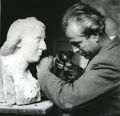He was born in 1909 in Panaitolio (Aetolia-Acarnania). He studied painting at the Athens School of Fine Arts (1930-1934) with Umberto Argyros and then sculpture in Paris with Marcel Gimond, until 1940. During the War and the German Occupation (1940-1945) he stayed in his home town, where he created many sculptures and models, working at the same time in tobacco fields. Throughout this period of his youth, he lived in great poverty and managed to survive on small grants (mainly by his fellow countrymen, like Papastratos Bros) or on financial support by friends.
In 1946, he settled in Athens and presented his first solo exhibition (Parnassus literary society, 1946), with great success. Since then, his star began to rise. His studio at Koukaki, in which he would later install his own foundry (1961), was aquired by a donation (1947). He also started working in Aegina during summer, with direct carving on limestone (tufa), marble or wood. His substantial production includes sculptures in various techniques, ceramic works, paintings, prints, etc.
His sculpture is anthropocentric, charged with expressive intensity. He moves away from classicistic naturalism, without acceding to aspects of modernism uncritically. The abstractionism and the rough lines characterizing his plastic idiom, often allude to the aesthetics of preclassical greek art.
He presented his work in numerous solo, group and international exhibitions. Among other artists, he represented Greece at the Venice Biennale (1962) and the Sao Paulo Biennale (1975). In 1981, a retrospective exhibition of his work was organized at the Athens National Art Gallery.
Two years after his death (Athens, 1993), the Athens Academy honored him with a retrospective exhibition at its premises (1995), and in 2004, a few of his wooden sculptures were presented at the opening of the National Sculpture Gallery.
In 2001 the Greek Parliament purchased his famous Frieze (Monument for the Battle of Pindus), which was placed at the Parliament’s peristyle in 2002. The work is based on models created during the ‘40s, which were transferred on tufa between 1952 and 1956.
His sculptures can be found at public places and in permanent exhibitions in Aegina (Christos Capralos Museum, since 1995) and Agrinio (Art Gallery-Sculpture Christos Capralos of Papastrateios Municipal Library, since 1996).
In 2006, the Foundation Christos and Souli Capralos (co-founded with his wife in 1991) was incorporated into the Athens National Art Gallery. His autobiography was published in 2001 and a monograph on his work was published in 2009.
Capralos Christos (1909 - 1993)





